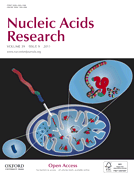Telomere function is influenced by chromatin structure and organization, which usually involves epigenetic modifications. We describe here the chromatin structure of Arabidopsis thaliana telomeres. Based on the study of six different epigenetic marks we show that Arabidopsis telomeres exhibit euchromatic features. In contrast, subtelomeric regions and telomeric sequences present at interstitial chromosomal loci are heterochromatic. Histone methyltransferases and the chromatin remodeling protein DDM1 control subtelomeric heterochromatin formation. Whereas histone methyltransferases are required for histone H3K92Me and non CpG DNA methylation, DDM1 directs CpG methylation but not H3K92Me or non CpG methylation. These results argue that both kinds of proteins participate in different pathways to reinforce subtelomeric heterochromatin formation.
This article has been selected as Featured Article by Nucleic Acids Research (top 5% of the articles). The article was highlighted as follows: It is a textbook concept that telomeres and centromeres fold into heterochromatin, which is important for their function. In many eukaryotes, telomeric sequences are abundant at internal chromosomal loci making difficult the study of telomeric chromatin structure. Here, the authors describe a procedure to independently analyze the chromatin structure of Arabidopsis thaliana telomeres and interstitial telomeric sequences (ITSs). They report for the first time the existence of euchromatic telomeres. Whereas Arabidopsis telomeres exhibit euchromatic features, subtelomeric regions and ITSs are heterochromatic. The authors propose that Arabidopsis telomeres impair heterochromatin formation and that heterochromatin at ITSs confer genome stability.



 English
English